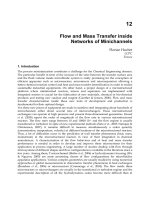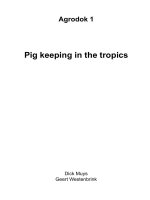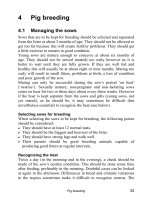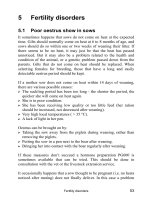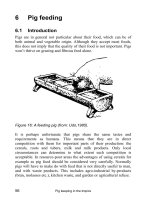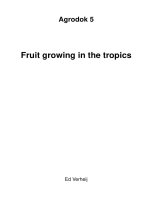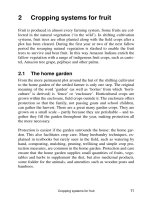Fruit growing in the tropics - Part 7 docx
Bạn đang xem bản rút gọn của tài liệu. Xem và tải ngay bản đầy đủ của tài liệu tại đây (19.88 KB, 4 trang )
Pollination and fruit set
55
7 Pollination and fruit set
7.1 Flowering habit
Without flowers there will be no fruit. Only pistillate (= female) flow-
ers set fruit. Staminate (= male) flowers produce the pollen needed to
pollinate pistillate flowers. Perfect (= hermaphrodite) flowers have
both pistils and stamens. Figure 17 shows the parts of a perfect flower.
Figure 17: The flower and its parts
Flowers borne singly or in small inflorescences (as in soursop, suga-
rapple, guava) are usually perfect, but inflorescences with many flow-
ers (like those in mango and rambutan) often contain imperfect flow-
ers as well. Strict segregation of the sexes is found in papaya for in-
stance: male and female inflorescences are on separate plants. This
segregation of the sexes on separate trees, which prevents self-
pollination, is called dioecy. Jackfruit and breadfruit are examples of
male and female inflorescences borne on the same tree (monoecy).
Fruit growing in the tropics
56
In banana and coconut flowers of both sexes are found in the same
inflorescence, the staminate flowers at the tip and the pistillate flowers
at the base. The large mango inflorescence bears both staminate and
perfect flowers.
The flowering habit of the fruit crops in this Agrodok is presented in
the Appendix. Flowering habits are rather varied. There are, for in-
stance, papaya cultivars in which all the plants bear fruit because they
are either female-flowering or bear perfect flowers. You can recognise
these cultivars because the perfect flowers are on long stalks (like
those of male plants) and the fruit is more elongated.
Flowering habit not only varies depending on the cultivar, it also var-
ies from year to year. The percentage pistillate flowers in coconut or
that of perfect flowers in mango may be much higher in one year than
in another, generally it is higher when growing conditions have been
favourable. Growing conditions also influence flower quality. A
healthy tree of moderate vigour bears strong flowers, the stigma being
receptive for pollination over a longer period of time to improve fruit
set.
7.2 Pollination
Flowers need to be pollinated in order to fertilise the ovule(s). The
fertilised ovules become the seeds; they produce hormones that ensure
that the flower sets fruit and that the fruit grows. In a few cases fruits
grow even without the stimulus from the seeds, so-called parthenocar-
pic fruit. Examples include pineapple, banana, and some cultivars of
other fruits, e.g. seedless guava and mandarin.
If the pollen comes from the same flower or from a flower on the
same tree this is called self-pollination. If the pollen comes from a tree
with a different genetic make-up, this is called cross-pollination.
Nowadays many fruit crops are cloned. Since all the plants in a clone
have the same genetic make-up, pollination within a clone is still self-
pollination.
Pollination and fruit set
57
Continued self-pollination in successive generations leads to inbreed-
ing, meaning a narrowing of genetic variation. As a rule this leads to
reduced vigour and fitness. This may be the reason why in many
plants form or function of the flowers makes self-pollination difficult
or impossible, thus favouring cross-pollination. One arrangement is
that the pistil is not receptive at the time that the stamens of that
flower shed their pollen, another that the stamens are too short for the
anthers to shed the pollen on the stigma. Self-pollination is impossible
if the genetic make-up of the pollen is not compatible with that of the
pistil, so that the pollen tube cannot grow down the style towards the
ovules (e.g. pineapple).
Apart from these adaptations to limit self-pollination, plants generally
produce more fruit following cross-pollination. If you grow a single
clone of a fruit crop, nearby seedling trees of that species may provide
the pollen to cross-pollinate the flowers on your trees. However, it is
generally safer to grow a few clones together in your orchard.
A good pollinator has VIABLE pollen that is genetically COMPATI-
BLE with the cultivar to be pollinated and FLOWERS AT THE SAME
TIME. Unfortunately this information is not available for most tropical
fruit crops. Therefore it may be wise to plant at least three cultivars
together and to try to make sure that the flowering periods of these
cultivars overlap. Should one of the three prove a poor pollinator,
chances are that the other two between them can assure cross-
pollination of all three cultivars.
Pollen may be transported by wind, but to carry the pollen from tree to
tree most tropical fruit crops rely on insects (honey bees), a few also
on birds (humming birds for pineapple in South America), or bats
(baobab, durian). The flowering habit and pollen transfer in some mi-
nor fruit crops has not yet been described. Flowering and pollination
of several important fruit crops – such as avocado, rambutan, oriental
persimmon – are too complex to be explained here. But these aspects
are so important that you should gather the information yourself, ei-
Fruit growing in the tropics
58
ther from knowledgeable people, publications, or your own close ob-
servation of the flowers on your trees and their visitors.
Dioecy presents a serious problem to the grower, especially where the
crop is grown from seed, as in the case of papaya, salak, rambai,
Amazon tree grape, butter fruit tree and oyster nut. Half the seedlings
will be male, but you cannot identify them until the trees flower, at
which time you can remove the ‘males’, leaving only 1 or 2 out of 20
to pollinate the ‘females’. It means you have wasted years to raise
these trees and are left with a plantation full of gaps. The only elegant
solution is to adopt clonal propagation: plant a female clone and inter-
plant with a compatible male clone in 5 – 10 % of the tree positions.
It is clear that cross-pollination is an important issue in fruit growing.
The grower should plant alternate rows of different cultivars or, if the
pollen comes from male trees, interplant these trees in the rows. A
windscreen may be needed to create shelter for the insects during the
flowering season (often hot, dry and windy). A beekeeper can assist by
placing hives in the orchard. Agrodok 32, ‘Beekeeping in the tropics’,
gives more information. In some cases the grower has to lend a hand;
hand pollination is often practiced on custard apples, passionfruits and
salak.
The Appendix gives brief information about the way in which pollina-
tion is effected in the listed fruit crops.

